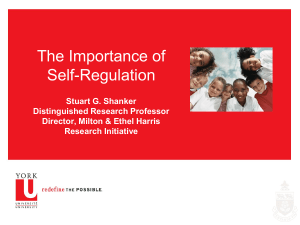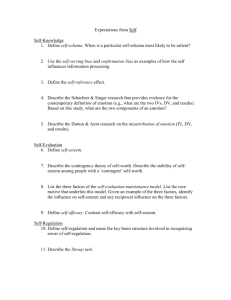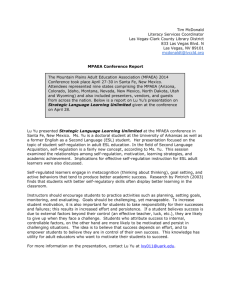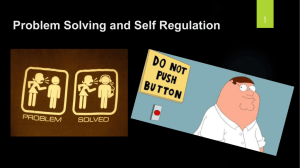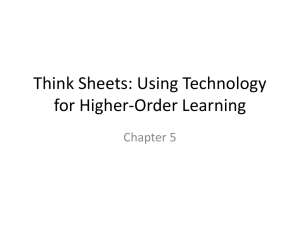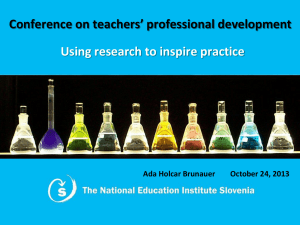Introduction to the Biological Domain
advertisement
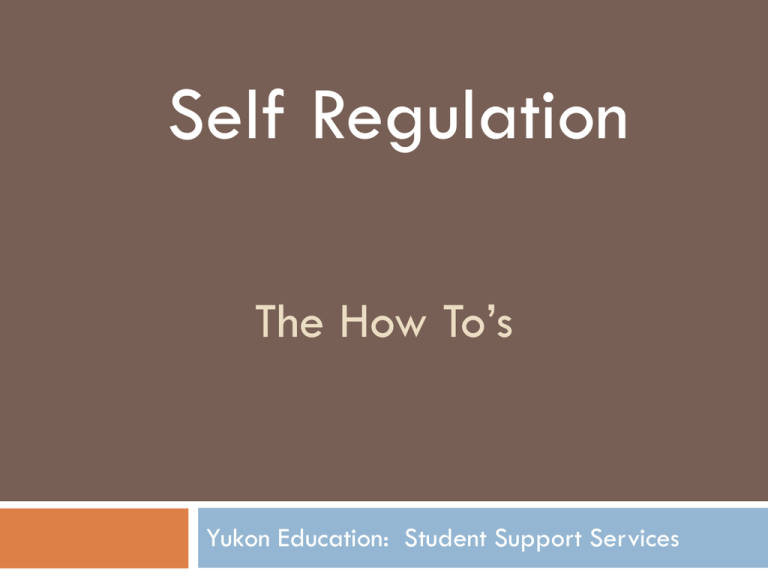
Self Regulation The How To’s Yukon Education: Student Support Services What do we mean by self-regulation? http://youtu.be/Q DlN_9fSAis 2 Personal Sensory Tools 1.To wake up in the morning, I … 2.When I have to listen at the staff meeting, I … 3.When I need to concentrate, the environment includes… 4. What I like best about my home… 5. When I am feeling stressed out I tend to __________ to help me feel better Yukon Context We live in a northern harsh climate Resiliency—darkness (hibernation) and re-emergence Intergenerational Trauma – black and white thinking; “for” or “against” – look for nuance We do same (must be in class) Can’t force but must guide energy (empty arbitrary requests) 4 Definition “Self-regulation is the ability to manage your own energy states, emotions, behaviours and attention, in ways that are socially acceptable and help achieve positive goals, such as maintaining good relationships, learning and maintaining wellbeing.” Stuart Shanker 5 Definition Recent studies show that children have far too much stress in their lives, because of biological, social, psychological, and/or environmental reasons How a child responds to a stressor and recovers from the effort In order to regulate we need to change intensity of stimuli (environment or adult) Gives lens for understanding child and it empowers the child 6 Self Regulation Recognizing and managing arousal levels Children acquire the ability to self regulate by first being regulated A newborn has no capacity to self regulate Some kids will need more external regulation from school due to an inability to internalize regulation techniques To Co-regulate- we need to be regulated ourselves as well, have relationships + Right Strategy Executive functioning: inhibit impulses and attention Self Regulation All behaviors are regulatory in nature Some impede with social interactions or learning Arousal levels are adjusted to meet task demands emotions, behaviors, and attention Everyone has different baselines of arousal & are affected by different stressors and stimuli (two children might expend very different amounts of energy in order to engage in the same activity) Different levels of energy expended to engage in a similar activity Energy expended depletes our resources which affects the attention span and ability to keep up with a lesson May lead to anger, withdrawal and/or anxiety Continuum of Arousal Hypoactive up-regulating State Range of Optimal SelfRegulation Calm Communicative Learning down-regulating Hyperactive State GOAL: To Recognize + Manage Arousal Self Regulation A child with good self regulation knows: Step 1: What it looks like to be calmly focused and alert in each domain Breathing/MINDUP Step 2: How to recognize stressors and how to return to the optimal state of regulation How do children learn? Observation: modeling Collaborative practice: Doing it together Supported practice: Doing it with guidance Independent practice Continuum of support NEED TO DOWN-REGULATE FOR LEARNING Adult regulation of environment Adult co-regulation Modeling down-regulating, doing together Adult support Turn down lights, create quiet & calm Reminders, guidance Check-in support Prompts for self-reflection, make connections, plans 5 DOMAINS OF SELF-REGULATION FOCUS ON BIOLOGICAL DOMAIN 5 Domains What does Calmly Focused look like? Biological Health Nutrition Sleep Exercise Sensory inputs Emotion Modulate emotions Cognitive Sustain & switch attention Social Perspective Impact of actions on Appropriate others task and language demands Pro-social Development of empathy: Doing the “right” thing Self-Regulation along the 5 Domains: 1. Matching energy level to the demands of a task or situation. 2. Monitoring and managing emotions. 3. Focusing attention and ignore distractions. 4. Understanding and engaging in social interactions. 5. Connecting with and caring about others. Baumeister & Vohs 15 Biological Domain Refers to activity or the level of energy in the human nervous system. Levels of energy vary widely from person to person, situation to situation, and across the day. Levels are influenced by individual personal sensory profile. 16 Key Attributes of a Well Regulated Biological Domain Physical health. Sufficient energy across the day; it is finite Ability to recoup energy after taxing experiences. Ability to follow healthy daily routines. 17 What does Calmly Focused look like? IMPLEMENTING SELF-REGULATION INITIAL STRATEGIES FOR SCHOOLS AND TEACHING STAFF: Behavioral Domain Self Regulation - Biological Domain (adapted from Stuart Shanker) Whole Class Modulate the intensity of stimuli in order to engage & sustain the child’s attention Reduce visual stimuli Reduce auditory stimuli Create a safe place Create a class climate Individual Provide additional external tools and strategies to a student following a referral by the School-Based Team to an occupational therapist and other consultants. Reduce Visual Stimuli Limit extraneous visual material on walls Use natural lighting and lamps Keep clutter to a minimum curtains over shelves Reduce Auditory Stimuli Arrange your classroom so that noisemaking activities are in one area and quiet activities are in another Tennis balls on legs of desks/chairs to reduce noise Reduce unnecessary noises (fans, computers left on, door clacking, bell buzzer vs. music or chime) Create a Safe Place Set up a safe space for down-regulation tent pillow pile rocking chair Plants Whole School Yoga , and active room and others cheer on Have a “go to” person for re-regulate (soothing); explicit teaching Create a Regulated Class Offer different seating options including yoga ball, cubby hole, standing up at desk, beanbag chair, exercise bike Tools to Try Supporting our Learners Individual Needs Enclosure, tent and curtains Movement Tools The most common ways to maintain attention or refocus ourselves e.g. go for a run/walk, stretching, tapping feet, wiggling leg, position changes. Back & forth, slow, rhythmical movement = calming Up and down, fast, un-rhythmical movements = alerting Biological Strategies Build in movement breaks: http://youtu.be/bJj6icP_mQ4: Be Smart Boogie Break http://www.youtube.com/watch?v=rPvv5HqYc60: Adventure to Fitness http://www.youtube.com/watch?v=2cNjAj_o0SI Cosmic kids yoga Build in brain breaks: http://www.youtube.com/watch?v=Zx9a7sxVeNM&feature=share&list=PLA96 80D909A10CDEA slap hand math http://youtu.be/3OM0pWnxnAA - Rock, paper, scissors Movement Strategies "Brain Break" sticks! Each popsicle stick has an activity on it (e.g. like spin 3x, jump rope, Macarena dance, jumping jacks, chair push-ups, seat swap, etc...}. http://3rd-grade-thoughts.blogspot.com/ In the Classroom - Movement 32 HOWEVER… Motion activities may result in dysregulated state. Follow up with breathing or proprioceptive input Motion combined with cognitive tasks may reduce dysregulation Motion combined with deep pressure helps to organize and refocus Chair pushup Wall presses Daily Practice Whole class Down-regulation Self-control games Language Up-regulation Peaceful music Tone of voice Volumne Pace Rhythm Words we use Simon Says Green light, red light Movement Breaks Yoga Exercise/boot camp Breathing Reading Martial arts Brain Gym Dimmed lights Following directions, patterns, recipes Bean-bag chair Stimulation Oral stimulationvolume and hydration stations Freeze tag Introducing the Language of Regulation Ensure that self-regulation concepts are clearly understood by the students Use age-appropriate vocabulary that develops a common understanding around self-regulation Students need to understand the vocabulary terms before they can be expected to use them For example, what do the terms Calm or Excited mean for the age group/developmental level you are working with? Match language length to comprehension level Teach the words, model their use, BEFORE expecting the students to use these words Introducing the Language of Regulation What do you need vs. what are you doing? Remember tone of voice and voice levels, pace and rhythm 2 Languages to teach: Analyze body language: Increase body awareness Increase emotional language but WHERE do I start? . in the BIOLOGICAL DOMAIN With yourself Teacher Wellness Self-care – helping ourselves first Self-regulation Regulated adults are better able to help kids achieve optimal regulation. What pushes my buttons & why? Balance our lives– being self aware & managing Be aware of biological influences on your functioning Regulate your biological domain Respond rather than react, being mindful Contagion Effect Be aware of how the relationships are affecting you Be aware of how you affect your students as regulated adults better able to help students achieve optimal regulation Wait… How does this work with the social-emotional learning programs like Mind-Up and Zones of Regulation? The short answer: All of these programs help to improve self-regulation! First Steps Take care of self by recognizing on regulatory needs Shift the environment: adaptations, visual/auditory stimuli Self-regulation areas in classrooms (up and down regulated areas) Scheduled movement and down regulated activities Use of self-regulation language (what do you need?) Mornings: integrate: food, sleep, talking circle, and yoga 40 Websites Canadian Self-Regulation Initiative (S. Shanker) http://www.self-regulation.ca (webinar 7, 8, 9 & 11) Brenda Whittam Neary - series of videos (lesson 3) http://www.youtube.com/watch?v=ve1D3U6zM7Y The Zones of Regulation http://www.socialthinking.com) Doodles, Dances and Ditties: A Somatosensory Handbook, Mount St. Vincent http://www.msvhome.org) Thank you!
